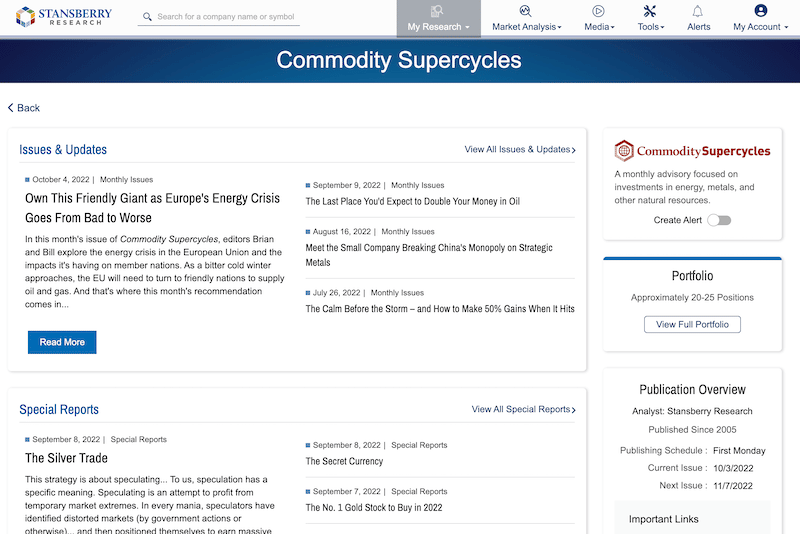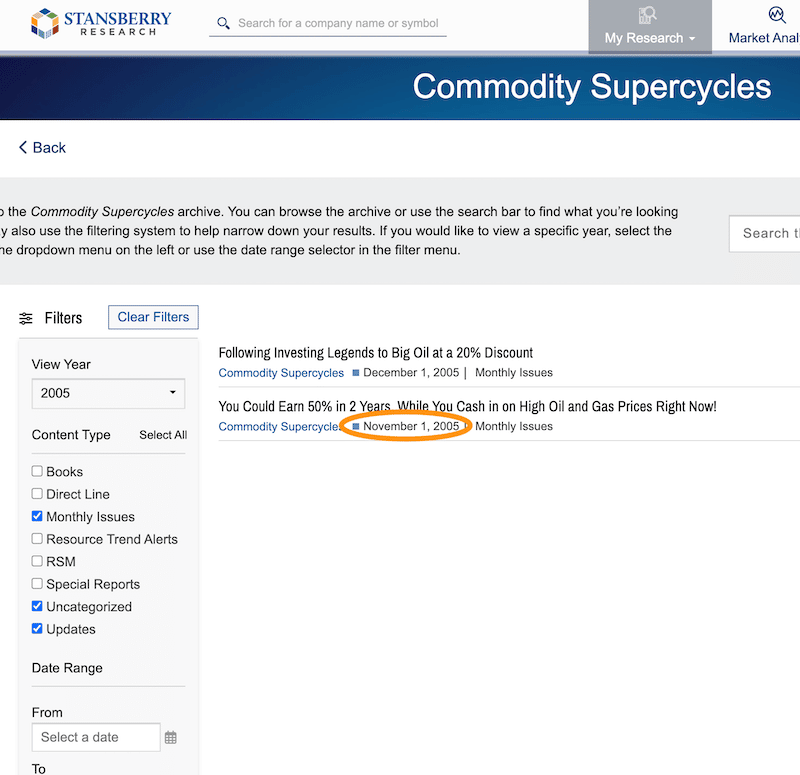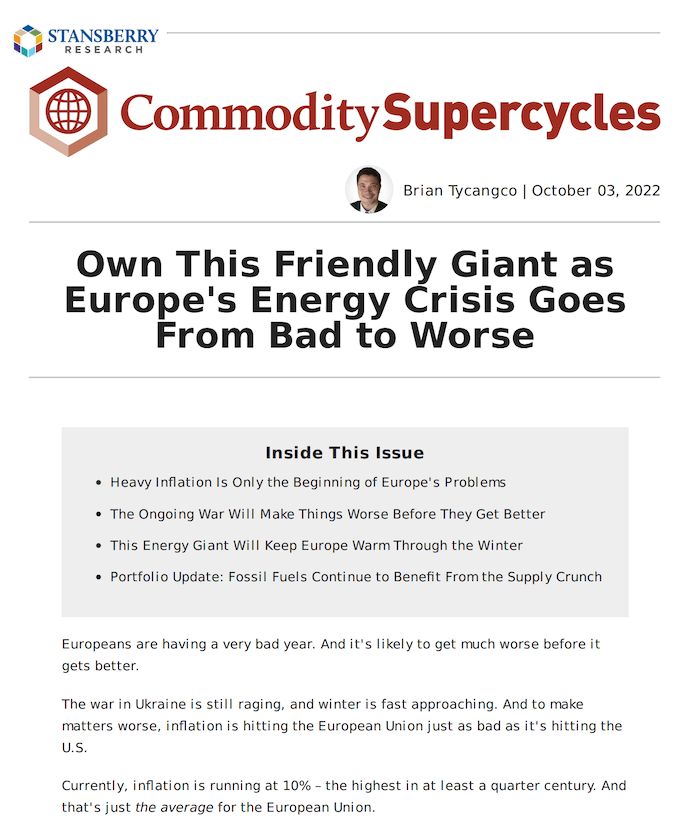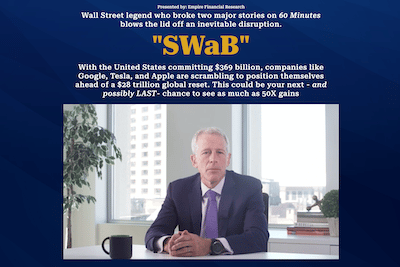Commodity Supercycles is a Stansberry Research investment advisory service focused on energy and natural resources stocks.
I first heard about it in mid-2021 while I was looking into a presentation about a nickel stock, and recently decided to give the service a try.
Long story short, I paid the (discounted) $59 to access the service and after digging through the membership, thought I’d share my take on it in this review.
Ahead, I’ll show you everything you need to know about the service before joining, including a “sneak peek” of how the stock picks are working out.
So with that said, let’s get started!
About Commodity Supercycles
Commodity Supercycles is an investment advisory service published by Stansberry Research focused on the energy and natural resources space.
As a subscriber, you get access to the current model portfolio (aka list of stock picks) and ongoing recommendations within the monthly newsletters.
As of writing, the recommendations mostly include oil and gas companies, industrial metal mining stocks, gold stocks, and agriculture companies.
I’ll go into more detail on the portfolio picks shortly, but the gist is that the recommendations are focused on a broad basket of natural resource companies. And the “energy” part of the portfolio makes up a large share of the current “winners.” At least as far as the “open” (active) recommendations go.
Who’s behind the service?
The previous editor of the service was Bill Shaw, who I’ve come across in the past when looking into different stock teasers.
But he appears to have left recently (mid-2022). And now, Brian Tycangco is the guy who writes the Commodity Supercycles newsletters.
Tycangco isn’t as well-known as some of Stansberry’s other analysts, but according to Stansberry Research, before joining the company in 2019, he ran a newsletter called Asian Growth Stocks for 17 years while he was based in Asia.
He also contributes to a newsletter called True Wealth, which is one of Stansberry Research’s flagship newsletters. And he ran a service called Visionary Investor in 2021, which focused mostly on tech, but that is no longer running.
Joining Commodity Supercycles
The price on the Stansberry Research sign-up page shows that Commodity Supercycles costs $199, but I managed to join for $59.
How? At first, I wasn’t sure. But after trying to replicate what I did, I found that if you click on the “start my trial subscription” button at the bottom of the page (instead of at the top of the page), you get that discount offer.
So that was cool.
Worth noting, however, is that the service is set to automatically renew for $199 after the first 12 months. So it’s only “cheap” for the first year.
Are there any upsells?
Many newsletter services hit you with immediate upsells after you join, but that wasn’t the case with Commodity Supercycles, which I think was because I joined through the main website rather than a “stock teaser” pitch.
Either way, Stansberry Research sells dozens of different services. And by subscribing to one of their services, you should probably expect to be pitched throughout your 12-month membership on different services they offer.
That’s just how these services work.
Recommended: Go here to see my #1 rated stock advisory of 2024
Overview of The Member’s Area
Once you sign up to Commodity Supercycles, this is the page you get access to:

This is the same member’s area you get access to regardless of which Stansberry Research service you join. And as I explained in my review of Retirement Millionaire (a different Stansberry Research service), it’s pretty comprehensive.
Aside from what comes with the core service itself (i.e., monthly newsletters and model portfolio), you get access to numerous tools and resources inside the member’s area, which are aimed at helping you get more out of the service.
For example, there are interactive stock charts, a stock screener tool, a page that gives you Stansberry’s ratings on different companies, and more.
Here’s a screenshot of the commodities section of the “Market Overview” page to give you an idea of what I’m talking about:

In short, the above tool allows you to click on any of the major global commodities and see a current price chart, as well as a 52-week price range. And it links you to an “advanced chart” if you want to focus on one commodity in particular.
Let’s be real… bells and whistles aren’t necessarily going to help you become a more successful investor.
But I have to admit that this is a pretty cool “side benefit” that Stansberry Research gives you as part of any newsletter subscription they sell.
In any case, now that you know what the service is about and have an idea of what the member’s area is like, let’s discuss the model portfolio and newsletters, as these are the two main components of the service.
Commodity Supercycles Portfolio (Stock Picks)
The Commodity Supercycles “Portfolio” page shows you all of the latest stocks that the service has recommended to subscribers.
And it’s currently broken down into four main themes:
- Metals and Minerals (8 picks)
- Agriculture (3 picks)
- Energy (10 picks)
- Speculative (2 picks)
There are currently 23 stocks in the model portfolio, and they all have a “buy” rating except for one stock. I can’t reveal the names of these companies because it’s a paid service, but here’s a “sneak peek” at how they’re doing as of writing:

As you can see from the above portfolio preview:
- All of the “Energy” picks are up.
- The “Metals and Minerals” and “Agriculture” picks are a mixed bag.
- And both of the “Speculative” picks are down.
- The best-performing pick is currently up 146% since March 2021, and the worst-performing pick is down 54% since May 2021.
Keep in mind that the above screenshot only shows you the open/active recommendations, though. As such, the “Return” column is subject to change each day the market is open until the service recommends selling the position.
Therefore, this is NOT a reliable way to gauge the service’s overall track record because it doesn’t show you how the picks have performed overall (winning and losing picks) from when the service began.
Instead, it only shows you the open positions.
Unless I’m missing something, Stansberry Research doesn’t give you access to a page that shows you the entire track record of the service. So the only way to figure that out would be to dig through the newsletter archives.
And since Commodity Supercycles first launched in 2005, piecing that together would be a nightmare of a task, to say the least. Because there are literally hundreds of individual pages that you’d need to dig through.

Needless to say, I didn’t trawl through 17-odd years’ worth of newsletters (lol), so I can’t tell you how well this service has performed since its inception.
I did, however, scan through a bunch of old newsletters and, in the process, learned some interesting “tidbits” about the service that I didn’t know.
For instance, I learned that Commodity Supercycles was originally edited by Matt Badiali, and at the time (2005), it was called “Oil Hunter.”
At some point along the way, the service was renamed “S&A Resource Report,” and Matt Badiali left in early 2017, at which point Bill Shaw stepped in.
And while it’s unclear when, at some point during Shaw’s reign, the service was renamed from S&A Resource Report to Commodity Supercycles.
Fast forward to mid-2022, and the baton was passed to Brian Tycangco, whose first Commodity Supercycles newsletter was published in July 2022.
Who cares?
Perhaps. But I guess my point is that even though it’s difficult to properly evaluate the service’s track record, you can glean some interesting insights by sleuthing through the newsletter archives, so you might find that useful if you join.
In any case, there’s a reason “they” say that past performance isn’t a good way to predict future results – because it’s not. So even if the service had a perfect track record, which it doesn’t, there’s no guarantee it’ll help you make money.
This is also why, aside from the recommendations, I like to consider the quality of the newsletter itself. Because regardless of how well the picks have worked out, you still may be able to gain some worthwhile insight from the content itself.
So let’s take a look at that aspect of the service now.
The Commodity Supercycles Newsletter
As a Commodity Supercycles subscriber, you get access to a new newsletter issue each month, which is currently being written by Brian Tycangco.
As you’d expect, the overall focus of the newsletters is on the natural resources sector, but each issue focuses on a different set of topics, depending on what’s happening in the global economy and markets.
For example, this month, the newsletter focused largely on inflation and the energy situation in Europe and explained how these things relate to the companies Tycangco is tracking in the model portfolio.

The length of each newsletter varies, but this one was 14 pages long, and I thought it was quite informative. Brian Tycangco goes into a lot of detail on his overall thesis, what he’s forecasting, and why he likes each company.
The newsletters also include relevant charts to help illustrate what has been discussed and a portfolio update section that breaks down any important information regarding the existing recommendations.
That’s pretty much it as far as the newsletters go.
And if you want more content in between the monthly newsletters, there are various “special reports” in the member’s area that discuss different companies the service recommends, and these are released periodically.
Is Commodity Supercycles a Scam?
Commodity Supercycles isn’t a scam.
There are some aspects of the service I didn’t like, and there is no guarantee that the stock picks will make you money, but it’s a legit service.
For $59, you get 12 months of access to the monthly newsletters, access to the model portfolio, and numerous tools and resources in the Stansberry Research member’s area. All in all, I’d say it’s a pretty good value service.
And it comes with a 30-day refund policy, too. So even if you join and decide you don’t like it, the company says you can request a refund in the first 30 days.
What don’t I like?
Usually, the number one thing I don’t like about these types of services (in general) is the marketing behind them. I personally find that it’s often unethical (i.e., flashy sales campaigns, upsells, annoying emails, etc.).
In this case, however, I joined directly through the Stansberry Research website, so I didn’t see a sales pitch or any upsells. And I haven’t been emailed about buying their other services (yet), although I’m sure that’s coming.
Nevertheless, there were a couple of things I didn’t like about it.
First, I think Stansberry Research could be more transparent about how well the service has performed since its inception. It’s possible I’m missing something, but from what I can see, this information is buried in the newsletter archives.
And second, the service automatically renews at $199, which isn’t exactly obvious when you sign up; it’s disclosed under the order form (where few people look).
The good news is that you can turn auto-renew off pretty easily.
All you need to do is click on the “account settings” link in the member’s area and navigate to where the system allows you to turn it off.
Bottom Line
All in all, I think Commodity Supercycles is a potentially worthwhile service for those looking for natural resources stock ideas and insights.
In particular, the service is currently focused a lot on energy-related companies, and oil and gas stocks make up a large share of those.
As mentioned, there are a variety of commodity-related recommendations in the portfolio, including gold, uranium, coal, and rare earth metals companies.
But the main focus is mostly on the energy sector as of writing.
Anyway, that’s my review.
Thanks for reading; I hope this helps you make a more informed choice.












Please note: By submitting a comment using the above comment form, you confirm that you agree with the storage and handling of your data by this site as detailed in our Privacy Policy.